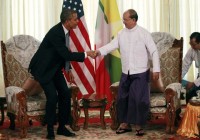
This post is written by Danny Hirschel-Burns, STAND Policy Coordinator. It is the first post in a series on Burma, which we are featuring as part of our Burma: Preventing the Next Mass Atrocity campaign. This post provides an overview of United States-Burma relations, while others will delve more in-depth into issues affecting Burma today.
Myanmar and the United States have not always had the friendliest bilateral relations, but just in the last two years, that is beginning to change. Following ongoing, partial democratic reforms that began in 2011, the United States has gradually moved toward restoring a functioning relationship, sometimes called normalizing relations. However, the United States should be cautious in its approach: there are still serious issues that the democratic reforms have not addressed.
The current cycle of relations between the United States and Myanmar (Myanmar commonly refers to the government, and Burma to the country) began in 1988, when the recently-installed military government brutally cracked down on the nascent pro-democracy movement. Two years later, Myanmar refused to honor the victory of Aung San Suu Kyi’s National League for Democracy in national elections, placing her under house arrest instead. In protest of the coup and the fraudulent elections, the United States removed its ambassador to the country. The crackdown on the 2007 Saffron Revolution led to the further deterioration of relations.
In 2011, Prime Minister Thein Sein was elected as President of Myanmar. Though he had previously served in the military and his political party has connections to the military, he is the first civilian president in forty-nine years. His administration has slightly rolled back military control of government, freed some political prisoners, and opened up Burma’s commercial and media sectors. In response to these changes, Hillary Clinton, then-Secretary of State, visited Burma in 2011, and in early 2012, announced that a United States ambassador would return to Burma. The United States has also cancelled some economic sanctions on the country, allowing for US dollars to enter the country. The prospect ofresuming military collaboration has been discussed, but so far there hasn’t been any concrete action.
While there has been some thawing of recent relations, some impediments to normalization remain in place. American businesses are allowed to invest in the state oil company, but this is contingent on notifying the State Department. Similar restrictions apply to businesses with large investments in the country. President Obama has also issued an executive order that has strengthened sanctions against individuals that work to prevent democratic reform. Finally, the United States still does not provide Myanmar with military aid due to the presence of child soldiers within the Myanmar army. Unlike Yemen and the DRC, it has not received a waiver to continue aid on the basis of American national security.
The United States should be wary of further normalization because of three main problems that remain in Burma. First, the democratic reforms that began two years ago are largelysuperficial. The military has a mandated 25% of seats in Parliament, Aung San Suu Kyi is barred from running for President because of an obscure constitutional clause designed specifically to target her, and the government continues to imprison prisoners of conscience. Second, the military continues to violate ceasefires with ethnic minority groups and commit human rights abuses in those areas. These grievances were highlighted in a recent open lettersigned by 133 ethnic minority organizations. Third, the government has failed to stop violence against Muslim (primarily Rohingya) residents of Burma, and in many cases the government is complicit in the attacks.
